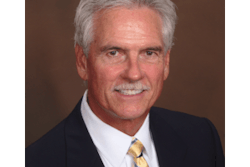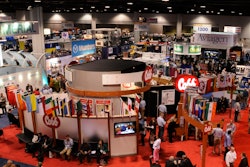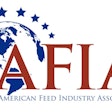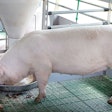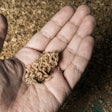2010年国际家禽世博会和能nal Feed Expo, held January 25 – 29 in Atlanta, covered an array of today’s most relevant topics during its five day educational program lineup.The American Feed Industry Association and the Poultry and Egg Institute summoned a host of the most progressive thinking minds in the poultry industry to speak at this year’s programs.
With presentation topics ranging from sustainability, animal welfare, new regulations and production optimization, there was something of value for each feed manufacturer, ingredient supplier, equipment manufacturer and industry service provider in attendance.
For those who didn’t attend the event, FEED & GRAIN provides a special report, summarizing the key messages presented this year.
At theInternational Education Forum,Keith Epperson, AFIA’s vice president of manufacturing and training, covered two developing issues: new chromium and manganese emissions regulations and the Oil Spill Prevention, Control, and Countermeasure ruling.
The National Emissions Standards for Hazardous Air Pollutants has added two compounds to its list of 187 hazardous air pollutants: chromium and manganese. These ingredients are used in varying percentages in nearly all animal feed, thus affecting 6,300 facilities in the United States, including feed manufacturing facilities and feedlots.
The ruling requires monthly cleaning to minimize dust, states that facilities must keep all doors closed to contain dust inside and rules that mixers and bags must be closed at all times.
At the load-out points, the space between the bin and the truck or railcar must be kept to a minimum (not defined) using drop filter socks, which very few facilities currently use. It also states that dust cyclones must be 95% efficient. Epperson said facilities with cyclones more than 10 years old will probably need to replace them in order to be compliant. The AFIA estimates that the equipment upgrades and additions could cost the industry an excess of $1.25 billion.
By May 5, 2010 facilities must inform the EPA of their chromium or manganese use and by May 14, 2012 compliance is mandatory. The AFIA and other feed and grain associations are working to revise many amendments to this ruling.
On November 9, 2009 the EPA announced the final amendments to the SPCC Rule. It states that facilities must report to the EPA when it spills more than 1,000 gallons of oil in a single discharge.
The ruling also imposes additional standards on oil storage, which may adversely affect feed facilities because it requires bulk storage containers to be elevated, stainless steel and uninsulated. Any new equipment or upgrades must be made by November 10, 2010, the date when compliance becomes mandatory.
Feed facilities may be exempt from the ruling by providing the EPA with documentation that oil from the facility does not have access to navigable waters. The documentation must be included in the facility’s SPCC plan, which is due by November 10, 2010. All facilities must submit an SPCC plan regardless if they are exempt or not.
The AFIA Forum also gave attendees an in-depth look at the safety and quality of rendered products for animal diets. Dr. David Meeker, National Renderer’s Association, said the rendering industry is valued at nearly $300 billion in the United States and Canada alone.
Rendering is the cooking and drying of meat products for feed and non-feed use. It’s one of the oldest forms of waste recycling and is essential to public health. Rendered meat is commonly used as a protein supplement in feed. Meat bone meal is comparable to soybean meal, but higher in protein, energy, phosphorus and zinc.
The NRA is currently researching potential non-feed markets, such as biofuels, that may be developed in the future.
The raw material for rendering comes from slaughter scraps, naturally deceased farm animals, restaurant grease, feathers and recalled meat.
To ensure the highest quality and sanitary measures are taken, the National Renderer’s Association has established a “Rendering Code of Practice.” The code states that renderers mustprocess at optimum temperatures over a prescribed length of time and use strict quality control procedures, good manufacturing practices and the principles of hazard analysis critical control points to produce protein meals and fats that are safe and reliable feed ingredients for animals.
NRA member facilities participate in third party audits, employ tractability methods, have well-trained staff and practice proper storage and receiving/shipping methods.
TheAnimal Agriculture Environmental Sustainability Summitcovered the importance of corporate sustainability from three perspectives: the government, the environmental organization and the corporation.
Christian Richter of The Policy Group Inc. outlined the progress and contributions to sustainability made by each president since George H.W. Bush.
The first Bush’s presidency was characterized by voluntary compliance with sustainability initiatives and forward thinking in providing sustainable solutions. During his administration the Environmental Protection Agency and industry worked together, rather than against one another.
The Clinton administration continued its predecessor’s collaborative approach to problem solving, but with a stronger emphasis on environmental results by granting tax breaks and other rewards to compliant companies. During this era complying with sustainability programs was still voluntary, but a growing public interest in issues such as global warming and depleting water supply increased participation a great deal.
乔治•布什(George w . Bush)总统可以被描述为a step backward on the sustainability front. As the EPA’s role was minimized, far fewer rules and initiatives were established than under the previous two presidents’ reign.
President Obama has put the EPA” back on the job” by hiring more investigators, giving more resources to inspection and enforcement and tightening regulatory standards. His aggressive approach to compliance has resulted in the dissolve of several key industry partnerships; a hindrance to the goal said Richter, because of the research and solutions provided by these corporations.
In closing, Richter pointed out that industry, not government, has been the main sustainability solutions provider, and the government isn’t giving credit where credit is due.
Suzy Friedman of The Environmental Defense Fund took the podium to provide the environmental group’s sustainability perspective. The EDF is undergoing a shift from filing lawsuits against objectionable corporations to collaborating with corporations on their sustainability efforts.
Companies voluntarily join the EDF to gain a better understanding of how they can become more sustainable. One benefit of joining the EDF is to gain access to online tools that collect data and provide documentation of performance and progress.
For some corporations, the thought of partnering with an environmental group may seem threatening, but Friedman said the first step is to let go of the “us vs. them” mentality.
“Not all big farms are bad, and not all environmental groups want to put you out of business,” said Friedman. “Collaboration between stakeholders who have diverse views helps make effective policies”
The EDF is also dedicated to coming up with economically viable solutions. The organization focuses on how to make sustainability affordable, instead of giving up when corporations say “this is too expensive.”
C. Larry Pope, CEO of Smithfield Foods, and a passionate believer in the importance of corporate sustainability, gave the corporate perspective.
In 1996 Smithfield Foods was slapped with a $12.5 million fine, the largest ever given under the Clean Water Act, for dumping hog waste from its Smithfield, VA processing plant into the nearby Pagan River.
Since then the giant meat corporation has made significant steps toward reforming its environmental policies. In fact, Smithfield hired the Department of Justice prosecutor responsible for its lawsuit to head up its new sustainability program.
Pope stresses that it’s in a corporation’s best interest to comply with environmental regulations, not only to avoid monetary consequences, but to maintain customer satisfaction.
“Skepticism of the food industry is increasingly becoming a deep-seeded problem, taught at the grade-school level and reinforced at home by housewives and mothers,” said Pope.
“Consumers are beginning to ask where their food comes from and non-compliance with sustainability and environmental rulings equals dissatisfied customers.”
To combat the public’s cynicism, Smithfield has stated policies on social responsibility, environment, labor and animal welfare. Pope stated that the United States employs the safest, most efficient ways to produce food, and the industry shouldn’t be demonized for that. Having sustainability programs in place and making them public is the best way to win over your customers again and earn their trust.





